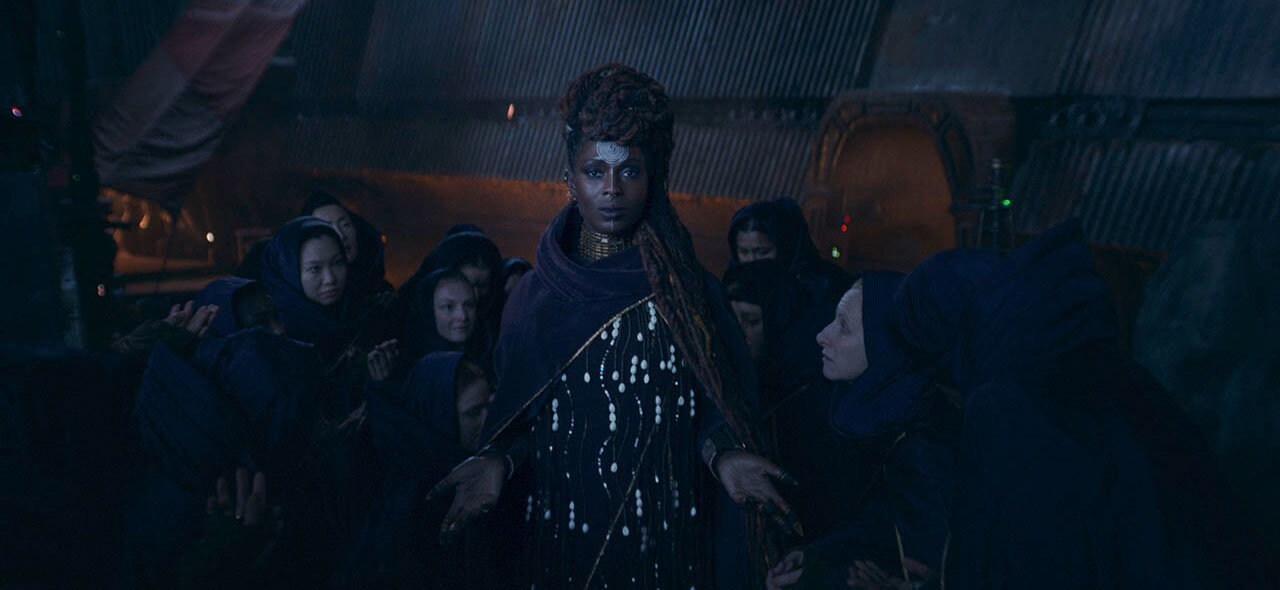
Running Commentary 6/17/2024
Hello,
I hope you all had a good Father's Day yesterday. My family celebrated with a picnic, and my father and I were able to hear warbling vireos in the trees; I got a quick glance at one as it flew between trees. That's my 159th bird spotted.
Anyway...
Watching...

The Acolyte
- The story following up last week’s premiere is still upcoming, as what we got this week was a flashback showing Osha’s experience 16 years ago. This episode doesn’t give a full picture of what happened then, but at least now the audience knows what the main hero knows, so we can find out anything else together.
- This episode immediately got a lot of hate, particularly for the dialog, particularly for the twins’ dialog. I…don’t disagree that a lot of it is very blunt and sort of first-draft feeling. I will say that, to a degree, that’s how 8-year-olds talk; if a little kid thinks something is bad, they’ll just say “x is bad”, they won’t try to come up with a more clever way of stating it. The script here isn’t a masterclass, but bad dialog is par for Star Wars; Andor’s dialog isn’t even that amazing in most scenes, but it stood out for basic competence in the midst of some pretty unimpressive company. I mean, I wish it was better, but I can’t say I expect much better.
- Osha did take some agency in this episode, like I said I wished she would last time, and everyone she knew died. Maybe that’s why she’s so passive as an adult.
- I feel like Mae was taking a lot of her violent behavior as cues from somebody. As much as she seems to be shown as a bad seed here, she’s also, in the context of this coven, the good daughter, where Osha is the rebellious problem child for not wanting to be a witch and sneaking out of her locked room into the outside. (That Osha and Mae were kept locked up wasn’t dwelt upon, since it may well have seemed normal to them, but it’s apparent in the way that Osha seems to have experience hotwiring her way out of her room and into some sort of service tunnels within the coven’s fortress.)
- The bird things looked pretty bad, not like they were there at all. Again, mostly this show looks pretty good, but there are some weak moments.
- I don’t think Sol told Osha the truth at the end, at least not nearly all of it. My guess is that the witches pooled their power to attack the Jedi, and when the Jedi repelled the attack it wiped the witches all out. They made a big deal out of unifying, so I could see that defeating them could become an all-or-nothing deal. I think the Jedi would still take that pretty hard, but I don’t think the Jedi set out to just plain massacre the witches to the last woman. We’ll have to see what more we learn as the show goes on; there’s still Mae’s perspective.
- The witches I don’t think are exactly Nightsisters; maybe some sort of off-shoot; definitely Darksiders, but not Sith; too collectivist to be Sith. Their practices might be illegal under Republic laws; we know from TRoS that the Sith Language was banned under Republic law following Ruusaan or Canon equivalent. This raises an interesting question: are Jedi the only sanctioned Force users in the High Republic? Are other Force traditions, not just the Sith, outlawed because, unlike the Jedi, they don’t swear fealty to the Senate?
- This episode at least broadly implies that Mother Aniseya created the twins through the Force, which brings Anakin's miraculous conception to mind. This might be splitting hairs, but, in terms of the Chosen One prophecy, I do think there's a difference between a person harnessing the Force to create life and the Force creating life spontaneously, as it did with Anakin. If anything, this would be the final nail in the coffin for the long-standing fan theory that Anakin was created by Sidious or Plagueis.

Bird of the Week
If you get into seeing birds, you'll gather a list of birds you've missed. This is different that your nemesis birds; those are the birds you should have seen. These are birds you could have seen, if you'd been somewhere the day before, and which you have little likelihood of seeing later. These are rare sightings, either vagrants from far away or secretive sorts, that you hear of someone else seeing one day but which have moved on by the time you go to get a look. I have a few of these: a roseate spoonbill, a flock of long-tailed ducks, a great horned owl. And one more, the most recent addition to the list: a Western Tanager
Much like the scarlet tanager, which I've drawn before, the western tanager has been found to not actually be a tanager, but rather a cardinalid.1 It is typically found in the western half of North America; its breeding range extends as far north as Canada's Northwest Territories, making it the northernmost-found member of the cardinal family. But, like many birds, it can fly, so it is occasionally found well to the east of its normal range. In one such case a male western tanager found itself in a neighborhood near the campus of Michigan State University, causing quite a stir during the two days it stayed, with many people arriving to get a glimpse, or better yet, a photograph, of a bird that should have been, at the nearest, in Wyoming. My father and I went to see it...on the third day. We found the very tree it had roosted in, and the very feeder it had fed from, but we were a day late to see the bird itself.
Much like its cousins, the western tanager is incredibly bright colors wasted on a bird that keeps high in trees under the shade of branches; it's not typically a very visible bird, except during migration. The red of a male western tanager's face is, unlike the red of others of its genus, derived entirely from its diet. During their breeding season, western tanagers eat a great deal of insects, which, in turn, feed on the buds of conifer trees, which contain a pigment called rhodoxanthin. The bird's metabolism absorbs the pigment from his insect prey and deposits it directly into his facial feathers. Depending on how well he does eating bugs, the redness of his face may vary.2,3
The western tanager was first described by Alexander Wilson, based on a specimen collected by Lewis and Clark from a river valley in what is now the state of Idaho. Meriwether Lewis wrote in his journal on June 6, 1806:4
The Kooskooske is about 150 Yds. wide at this place and discharges a vast body of water; notwithstanding it high state the water remains nearly transparent, and it's temperature appears to be quite as cold as that of our best springs. We meet with a beautifull little bird in this neighbourhood about the size and somewhat the shape of the large sparrow. It is reather longer in proportion to it's bulk than the sparrow. It measures 7 inches from the extremity of the beek to that of the tail, the latter occupying 2½ inches. The beak is reather more than half an inch in length, and is formed much like the virginia nitingale; it is thick and large for a bird of it's size; wide at the base, both chaps convex, and pointed, the upper exceeds the under chap a little 〈and a〉 is somewhat curved and of a brown colour; the lower chap of a greenish yellow. The eye full rather large and of a black colour both purple and iris. The plumage is remarkably delicate; that of the neck and head is of a fine orrange yellow and red, the latter predominates on the top of the head and arround the base of the beak from whence it graduly deminishes & towards the lower part of the neck, the orrange yellow prevails most; the red has the appearance of being laid over a ground of yellow.
Wilson, who had already named a woodpecker for Lewis and a nutcracker for Clark, named the tanager after the new territory that the two were tasked with exploring, calling it Tanagra ludoviciana, the "Louisiana tanager",5 which was the common name the bird went by for some time; In his two-volume 1909 work The Birds of Washington, William Leon Dawson struggles to call it the "crimson-headed tanager", a newer, less confusing term for a bird not found anywhere in or near the state of Louisiana.6 The western tanager is now known to science as Piranga ludoviciana, it and other similar "tanagers" having been placed in a genus named after the Tupí word for a small, flame-colored bird.
- “Proposal (318) to South American Classification Committee – Transfer Piranga, Habia, and Chlorothraupis to Cardinalidae,” 2007. https://www.museum.lsu.edu/~Remsen/SACCprop318.htm.
- Mitchell, Tina. “On Display—The Western Tanager.” Buena Vista Audubon, May 30, 2021. https://bvaudubon.org/2021/04/16/on-display-the-western-tanager-by-tina-mitchell/.
- Hudson, Jocelyn. “Unusual Carotenoid Use by the Western Tanager (Piranga Ludoviciana) and Its Evolutionary Implications.” Canadian Journal of Zoology 69, no. 9 (September 1, 1991): 2311–20. https://doi.org/10.1139/z91-325.
- Lewis, Meriwether. “June 6, 1806." Journals of the Lewis and Clark Expedition, 1806. https://lewisandclarkjournals.unl.edu/item/lc.jrn.1806-06-06#n35060602.
- Jobling, J. A. (editor). The Key to Scientific Names in Birds of the World (S. M. Billerman et al. editors), Cornell Laboratory of Ornithology, Ithaca.
- Dawson, William Leon, and John Hooper Bowles. The Birds of Washington: A Complete, Scientific and Popular Account of the 372 Species of Birds Found in the State, 1909. pp 170-172
Curation Links
Radioactive drugs strike cancer with precision | Elie Dolgin, Knowable Magazine
A history of radiotherapy, from the earliest forms of x-ray therapy to developing methods of targeted beta and alpha emitters that can target tumors while leaving surrounding tissue largely unaffected.
The Suit, Savile Row, and Smartly Dressed Men | Tom Holland & Dominic Sandbrook, The Rest is History
[AUDIO] “The suit has long served as the official attire of men in Britain, Europe and the Western World. Traditionally the uniform of the elites and an indicator of class, its purpose and design has evolved over time. Notably, in the great sweep of clothing throughout human history – from the Roman toga to the ancient Egyptian shendyt – the suit is unusual for the way that it hugs the body, rather than hanging off it. What then is the origin of this most venerable of fashions? And why has it conventionally been so much more constrained and less flamboyant than women’s clothing?” (1 hour)
Dawn’s Early Light | Frederick A. Cook, Lapham's Quarterly
"From Through the First Antarctic Night. After earning his medical degree from New York University in 1890, Cook served as surgeon on several Arctic expeditions. In January 1898 he became the first American to visit both polar regions when a Belgian expedition he had joined reached Antarctic waters. Cook helped to keep his shipmates alive while the ship was trapped in sea ice for more than a year"
Out of Print | Wen Wen Yang, Apex Magazine
[FICTION] A character from an old novel fades as the book is reinterpreted, but more often simply forgotten, by the reading public.
See the full archive of curations on Notion






Member Commentary